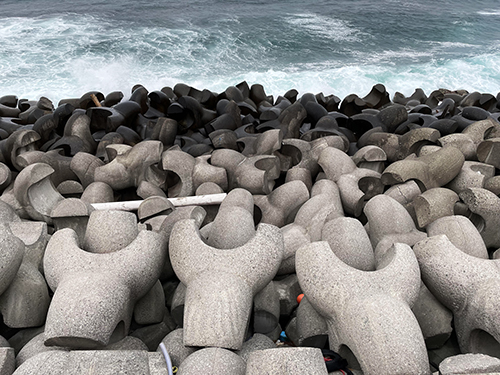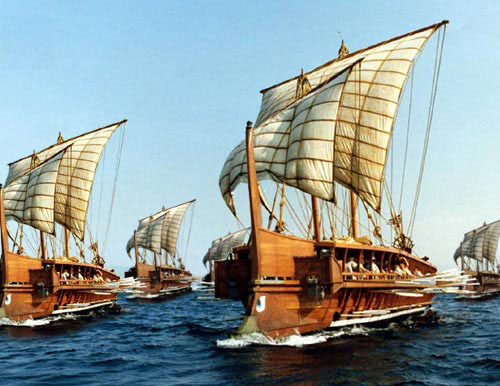


日本の交通の歴史では基本的には日本海海上交通が主役だったとされている。阿部比羅夫の北方遠征が200艘という大船団で北海道まで遠征可能だったことは、659年当時、それだけの海上交通の技術が発展していたことを表している。その直後の白村江海戦への日本艦隊の出撃もそのことを表している。
阿部比羅夫は白村江敗戦のあと、太宰府の長官職について来襲が予測された唐と新羅の連合艦隊に対して国防長官的な任務に就いていた。そのことはかれとその勢力が当時の海上交通の最先端技術集団だったことを知らしめていると思う。
積丹半島手前までの地域との間では日本の海上交通ネットワークは機能したのだろうけれど、しかし、その後の歴史ではながく積丹半島以北地域、札幌などの石狩湾地域は歴史痕跡が発現しない。先日触れたように、積丹半島の先端、神威岬以北は「女人禁制」とされたことで日本社会とは隔絶された化外の地として無視され続けることになった。
日本のヤマト政権が白村江などの朝鮮半島との緊張拡大方向に進まず、阿部比羅夫北方遠征の方向で主たる進出方向を北方に向けていれば、日本史はまったく違う展開を見せていたのかも知れない。上の写真は積丹半島の荒ぶる海と海岸線の様子。こういう難所に対して当時の兵員大量輸送の船の想像図を対置してみた。これは当時のWiki画像で見たヨーロッパの木造船イラストだけれど、想像では日本の阿部比羅夫船団も似たような様相だったと思える。
こういう船を作り,運航して日本海海域を移動進軍できていたのだから、その技術をさらに進化発展させればいかに難所とは言え、積丹半島を超えて石狩湾地域を開発することは十分に可能だったのではないか。明治以降、札幌を北海道の首府と定めて開発に着手してから150年の現在をみれば、地域のポテンシャルを生かし切れなかったこの間の歴史経緯が残念。「北のウォール街」とまで称された小樽の発展などの事例を見れば、659年から以降の平安期などで相当の発展は見込めたのではないか。
まぁその果実は奥州藤原政権が獲得して、独自の政権維持の大きな要素にしたということなのだろう。ただ、奥州藤原氏はむしろ、苫小牧周辺から日高方面に強い志向性を持っていたようだ。アイヌ社会との交易痕跡がこれらの地域に散見されることになる。
・・・さて本日から東京ビッグサイトでの「AI人工知能EXPO」に出張。ちょうど新事業でAIを活用していることもあってその協力企業のブースなどで最新情報に触れたいと思っています。
English version
Shakotan Peninsula: A super difficult place for boat traffic! Shakotan Peninsula Coastline Topography
Since the Japanese center symbolized by Abe Hirao came as far as the Goshi area, could the Sapporo area have participated in Japanese history from the Heian period if shipbuilding operation technology had been developed a little? …
In the history of Japanese transportation, the Sea of Japan maritime transportation basically played the leading role. The fact that Abe Hirao’s northern expedition was able to travel as far as Hokkaido with a fleet of 200 ships indicates that the technology of maritime transportation had developed to that extent in 659. The Japanese fleet’s expedition to the Battle of Hakuchon River immediately after the Battle of Hakuchon also indicates this.
After the defeat at the Hakuchon River, Abe Hirao was appointed as the chief of Dazaifu, and was assigned as the secretary of defense against the combined fleet of Tang and Silla, which was expected to attack Japan. This shows that he and his forces were the most advanced technological group in maritime transportation at that time.
Although Japan’s maritime transportation network may have functioned in the area up to the Shakotan Peninsula, for a long time afterwards, no traces of the history of the area north of the Shakotan Peninsula and the Ishikari Bay area, including Sapporo, appeared. As mentioned earlier, the area north of Cape Kamui, at the tip of the Shakotan Peninsula, was considered a “no women’s area” and was ignored by Japanese society as an outcast area.
If the Japanese Yamato regime had turned its main direction of expansion toward the north in the direction of the Abe-Hirau Northern Expedition, instead of moving in the direction of increased tensions with the Korean Peninsula, such as the Hakumura River, Japanese history might have developed in a completely different way. The photo above shows the rough sea and coastline of the Shakotan Peninsula. I have juxtaposed an imaginary image of a ship transporting a large number of soldiers at that time against such a difficult place. This is an illustration of a European wooden ship from a Wiki image of the time, but I imagine that the Japanese Abe-Hirau fleet was similar in appearance.
Since they were able to build and operate such ships to move and march in the Sea of Japan, it would have been possible to develop the Ishikari Bay area beyond the Shakotan Peninsula, no matter how difficult it was, by further advancing and developing their technology. Looking at the present 150 years since the Meiji era, when Sapporo was designated as the capital of Hokkaido and development began, it is regrettable that the potential of the region has not been fully utilized. Looking at examples such as the development of Otaru, which was even called the “Wall Street of the North,” we can see that considerable development could have been expected during the Heian period from 659 to the present.
Well, the Oshu Fujiwara government acquired the fruits of this development and made it a major factor in maintaining its own government. However, it seems that the Oshu Fujiwara were rather strongly oriented toward the Hidaka area from the Tomakomai vicinity. Traces of trade with the Ainu community can be found in these areas.
Now, I am going to Tokyo Big Sight for the “AI Artificial Intelligence EXPO” starting today. As I am using AI in my new business, I would like to get acquainted with the latest information at the booths of cooperating companies.
Posted on 5月 11th, 2023 by 三木 奎吾
Filed under: 日本社会・文化研究







コメントを投稿
「※誹謗中傷や、悪意のある書き込み、営利目的などのコメントを防ぐために、投稿された全てのコメントは一時的に保留されますのでご了承ください。」
You must be logged in to post a comment.